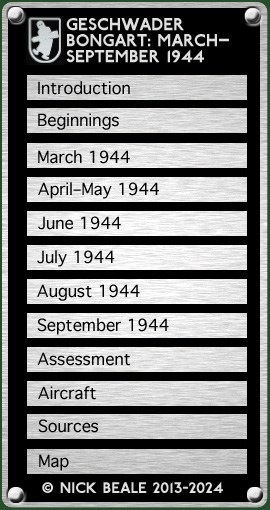|
Operating out of Clermont-Ferrand, Bongart aircraft attacked three hamlets in the countryside south east of Limoges, as described in the memoirs of Resistance leader Georges Guingouin. He alleges that the Germans had a source—one “Viscomte de R…”—in the ranks of the Maquis and that he passed on intelligence allowing the Germans to bomb and strafe the Brigade command post at La Villa de Sussac and Battalion HQ’s in Poumeau and Amboirat: “Magnificent performance that day on the part of a Maquis Bren-gunner: a Focke-Wulf 190 was shot down”. Early that afternoon, Reggiane Re. 2002 W.Nr. 1256, “5” (DV+BI) belly-landed in a field near Jumeau-le-Grand, losing a wing in the process. It was said to have been brought down by Resistance fighter Franc Comboc, with a machine gun. Since a broken airscrew blade was found in the woods, it was later argued that the Reggiane may have suffered a synchronisation failure and shot its own propeller off. The pilot evaded capture and apparently reached German forces. Odette Frachet, then 12 years old, recalled that she and her friends counted some seven aircraft circling over Amboiras. Aside from bombing, these also strafed the hedgerows where they suspected Résistants were hiding. Other witnesses stated that the pilot got out and asked the way to Limoges, getting away as fast as he could. Later, German soldiers came to find him. After the war, the aircraft’s fuselage was installed as a monument in Limoges and in 1976 was removed for restoration (with considerable artistic licence) and exhibition in a museum.
A message from ZG 1’s Operations Officer made clear that only the 2. Staffel would be moving to Châteauroux, where it would be subordinate to Geschwader Bongart for operations. Specific references to any combat missions by the Staffel after its arrival are lacking, unfortunately. 17 June The 2./ZG 1’s Albrecht Bellstedt carried out two more anti-partisan Frontflüge, giving only his generic description of the target, “assemblies of vehicles, villages, tented camps”. More detail was given by Lfl. 3 which noted that during the morning Geschwader Bongart had undertaken reconnaissance of terrorist camps in the areas Grenoble – Valence – Montélimar and from Clermont-Ferrand to NE of Bourges. Luftflotte 3’s report of the day’s operations as of 2300 hours on the 17th included: Geschwader Bongart: 37 aircraft in concentrated attack against bandit groups in the area SE Limoges round Sussac, St. Gisses and Châteauneuf. Results: Château Sussac, supposed HQ of the bandits, hit. Burned for a short time. Farmstead behind it shot into flames. Strafing and bombing of assemblies of vehicles in front of the Château, farmstead in the forest of Châteauneuf. Fires in the forest of Châteauneuf. Fire with strong development of smoke and explosion, probably hit on munitions dump. A farmstead west of Sussac, in front of which four lorries were standing, shot into flames. In total 13 lorries severely damaged, of which six burned. Further appreciable damage to lorries and personnel casualties may be counted on with certainty, above all in the forest of Châteauneuf. Bombing of three machine gun emplacements in the forest of Combrat. Losses: 1 aircraft made emergency landing in bandit territory. This section of report clearly relates to events on 16th given the target area and the aircraft coming down in enemy territory (unless every source about the latter is incorrect).
18 June Combating gangs: planned operation called off. In addition, air-dropping of propaganda leaflet aimed at desertion of forcibly-recruited terrorists. Notes of Army Group G discussion After heavy losses over the Allied beach heads in Normandy, on 18 June it was announced that 12 of III./SG 4's Fw 190s would be withdrawn immediately to Clermont-Ferrand and that the rest of the Gruppe would follow later. A number of aircraft flew from Laval, via Tours, to Clermont the next day but bad weather meant that others were unable to make the move. During the morning Geschwader Bongart made a “concentrated attack against strong bandit groups” in the area SE of Limoges, at Cousssac-Bonneval, St. Gilles and Châteauneuf. Not all the Luftwaffe bombs dropped away from the Normandy battlefront were aimed at the Resistance. A Ju 88 of II./KG 76 was forced to jettison its two BM 1000 mines near Orléans. Four days later, the military authorities warned that such weapons “must on no account be discovered by the local inhabitants and so made accessible to the enemy”. Impact points were recognisable by the parachute or by a hole in the ground 70 cm in diameter and around 2 m deep and must be guarded while Luftwaffe assistance was summoned, since it was “particularly dangerous to remove individual parts”. The mines had still not been found by 11 July, giving rise to anxiety that the secrecy of their AD 104 fuses had been compromised and prompting a directive that if more than 20 km from base the BM 1000 must be jettisoned live. continued on next page …
|
||||

